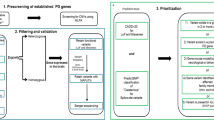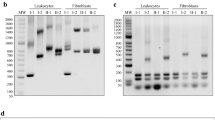Abstract
We aimed to detect the causative gene in five unrelated families with recessive inheritance pattern neurological disorders involving the central nervous system, and the potential function of the NEMF gene in the central nervous system. Exome sequencing (ES) was applied to all families and linkage analysis was performed on family 1. A minigene assay was used to validate the splicing effect of the relevant discovered variants. Immunofluorescence (IF) experiment was performed to investigate the role of the causative gene in neuron development. The large consanguineous family confirms the phenotype-causative relationship with homozygous frameshift variant (NM_004713.6:c.2618del) as revealed by ES. Linkage analysis of the family showed a significant single-point LOD of 4.5 locus. Through collaboration in GeneMatcher, four additional unrelated families’ likely pathogenic NEMF variants for a spectrum of central neurological disorders, two homozygous splice-site variants (NM_004713.6:c.574+1G>T and NM_004713.6:c.807-2A>C) and a homozygous frameshift variant (NM_004713.6: c.1234_1235insC) were subsequently identified and segregated with all affected individuals. We further revealed that knockdown (KD) of Nemf leads to impairment of axonal outgrowth and synapse development in cultured mouse primary cortical neurons. Our study demonstrates that disease-causing biallelic NEMF variants result in central nervous system impairment and other variable features. NEMF is an important player in mammalian neuron development.




Similar content being viewed by others
Abbreviations
- AR:
-
Autosomal recessive
- RoH:
-
Regions of homozygosity
- LOD:
-
Log of the odds
- shRNA:
-
Short hairpin RNA
- ID:
-
Intellectual disability
- KD:
-
Knockdown
- ES:
-
Exome sequencing
- IF:
-
Immunofluorescence
- PBS:
-
Phosphate-buffered saline
- DD:
-
Developmental delay
- RQC:
-
Ribosome-associated quality control
References
Anazi S, Maddirevula S, Faqeih E et al (2017) Clinical genomics expands the morbid genome of intellectual disability and offers a high diagnostic yield. Mol Psychiatry 22(4):615–624
Bauer P, Kandaswamy KK, Weiss MER et al (2019) Development of an evidence-based algorithm that optimizes sensitivity and specificity in ES-based diagnostics of a clinically heterogeneous patient population. Genet Med 21(1):53–61
Belmonte MK, Allen G, Beckel-Mitchener A, Boulanger LM, Carper RA, Webb SJ (2004) Autism and abnormal development of brain connectivity. J Neurosci 24(42):9228–9231
Bergant G, Maver A, Lovrecic L, Cuturilo G, Hodzic A, Peterlin B (2018) Comprehensive use of extended exome analysis improves diagnostic yield in rare disease: a retrospective survey in 1059 cases. Genet Med 20(3):303–312
Chicurel ME, Harris KM (1992) Three-dimensional analysis of the structure and composition of CA3 branched dendritic spines and their synaptic relationships with mossy fiber boutons in the rat hippocampus. J Comp Neurol 325(2):169–182
Chu J, Hong NA, Masuda CA et al (2009) A mouse forward genetics screen identifies LISTERIN as an E3 ubiquitin ligase involved in neurodegeneration. Proc Natl Acad Sci USA 106(7):2097–2103
Cooper TA (2005) Use of minigene systems to dissect alternative splicing elements. Methods 37(4):331–340
Eggermann K, Gess B, Hausler M, Weis J, Hahn A, Kurth I (2018) Hereditary Neuropathies. Dtsch Arztebl Int 115(6):91–97
Fiala JC, Spacek J, Harris KM (2002) Dendritic spine pathology: cause or consequence of neurological disorders? Brain Res Brain Res Rev 39(1):29–54
Gurgel-Giannetti J, Lynch DS, Paiva ARB et al (2018) A novel complex neurological phenotype due to a homozygous mutation in FDX2. Brain J Neurol 141(8):2289–2298
Hui KK, Chen YK, Endo R, Tanaka M (2019) Translation from the ribosome to the clinic: implication in neurological disorders and new perspectives from recent advances. Biomolecules 9(11):680
Karczewski KJ, Francioli LC, Tiao G et al (2019) Variation across 141,456 human exomes and genomes reveals the spectrum of loss-of function intolerance across human protein-coding genes
Lathrop GM, Lalouel JM, Julier C, Ott J (1985) Multilocus linkage analysis in humans: detection of linkage and estimation of recombination. Am J Hum Genet 37(3):482–498
Lek M, Karczewski KJ, Minikel EV et al (2016) Analysis of protein-coding genetic variation in 60,706 humans. Nature 536(7616):285–291
Li H, Durbin R (2009) Fast and accurate short read alignment with Burrows–Wheeler transform. Bioinformatics 25(14):1754–1760
Long SW, Ooi JYY, Yau PM, Jones PL (2011) A brain-derived MeCP2 complex supports a role for MeCP2 in RNA processing. Biosci Rep 31(5):333–343
Martin PB, Kigoshi-Tansho Y, Sher RB et al (2020) NEMF mutations that impair ribosome-associated quality control are associated with neuromuscular disease. Nat Commun. https://doi.org/10.1038/s41467-020-18327-6
Maver A, Lovrecic L, Volk M et al (2016) Phenotype-driven gene target definition in clinical genome-wide sequencing data interpretation. Genet Med 18(11):1102–1110
McKenna A, Hanna M, Banks E et al (2010) The Genome Analysis Toolkit: a MapReduce framework for analyzing next-generation DNA sequencing data. Genome Res 20(9):1297–1303
Nowakowski TJ, Bhaduri A, Pollen AA et al (2017) Spatiotemporal gene expression trajectories reveal developmental hierarchies of the human cortex. Science 358(6368):1318–1323
Ramchandren S (2017) Charcot–Marie–Tooth disease and other genetic polyneuropathies. Continuum (Minneap Minn) 23(5):1360–1377
Seelow D, Schuelke M, Hildebrandt F, Nurnberg P (2009) HomozygosityMapper—an interactive approach to homozygosity mapping. Nucleic Acids Res 37(Web Server issue):W593–599
Shao S, Brown A, Santhanam B, Hegde RS (2015) Structure and assembly pathway of the ribosome quality control complex. Mol Cell 57(3):433–444
Shen PS, Park J, Qin Y et al (2015) Protein synthesis. Rqc2p and 60S ribosomal subunits mediate mRNA-independent elongation of nascent chains. Science 347(6217):75–78
Shibayama A, Cook EH Jr, Feng J et al (2004) MECP2 structural and 3'-UTR variants in schizophrenia, autism and other psychiatric diseases: a possible association with autism. Am J Med Genet B Neuropsychiatr Genet 128B(1):50–53
Sitron CS, Brandman O (2019) CAT tails drive degradation of stalled polypeptides on and off the ribosome. Nat Struct Mol Biol 26(6):450–459
Sommer C, Geber C, Young P, Forst R, Birklein F, Schoser B (2018) Polyneuropathies. Dtsch Arztebl Int 115(6):83–90
Wang K, Li M, Hakonarson H (2010) ANNOVAR: functional annotation of genetic variants from high-throughput sequencing data. Nucleic Acids Res 38(16):e164
Zagrebelsky M, Holz A, Dechant G, Barde YA, Bonhoeffer T, Korte M (2005) The p75 neurotrophin receptor negatively modulates dendrite complexity and spine density in hippocampal neurons. J Neurosci 25(43):9989–9999
Zahorakova D, Rosipal R, Hadac J et al (2007) Mutation analysis of the MECP2 gene in patients of Slavic origin with Rett syndrome: novel mutations and polymorphisms. J Hum Genet 52(4):342–348
Acknowledgements
We are especially grateful to the families that participated in this study. We thank Tomasz J. Nowakowski for sharing the single-cell RNA-seq data of the human developing cerebral cortex.
Funding
The following grants supported this work: the National Natural Science Foundation of China (81671122) and the Science and Technology Major Projects of Hunan Province Science and Technology Department (2018DK2016) to Zhengmao Hu.; the National Natural Science Foundation of China (81730036, 81525007) and the Science and Technology Major Projects of Hunan Province Science and Technology Department (2018SK1030) to Kun Xia.; the National Natural Science Foundation of China (31671114, 81871079) to Hui Guo; Hainan Provincial Department of Science and Technology (CN) (2016RS2001, 2016JC2055).
Author information
Authors and Affiliations
Corresponding authors
Ethics declarations
Conflict of interest
The authors declare no conflicts of interest.
Additional information
Publisher's Note
Springer Nature remains neutral with regard to jurisdictional claims in published maps and institutional affiliations.
Rights and permissions
About this article
Cite this article
Ahmed, A., Wang, M., Bergant, G. et al. Biallelic loss-of-function variants in NEMF cause central nervous system impairment and axonal polyneuropathy. Hum Genet 140, 579–592 (2021). https://doi.org/10.1007/s00439-020-02226-3
Received:
Accepted:
Published:
Issue Date:
DOI: https://doi.org/10.1007/s00439-020-02226-3




